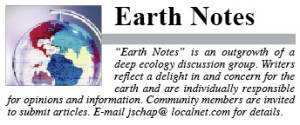Sizing Up Our Choices
By Sally Chappell
 I never imagined so much American culture and history could fit into such a tiny place, but that is the case with Bridgton’s Rufus Porter Museum.
I never imagined so much American culture and history could fit into such a tiny place, but that is the case with Bridgton’s Rufus Porter Museum.
If you haven’t already explored this gem of a museum, make a point of visiting sometime this summer to learn about this fascinating figure in Bridgton’s past. During my first visit recently, our excellent tour guide pointed out two similar items that, except for their size, were identical. One was a fake, the other, authentic. Even to the practiced eye, it is difficult to tell the difference. As you can guess, there is a big difference in the value of the two pieces irrespective of size disparity.
So, it is with our food. Some of it is real, and some is fake. As with the museum pieces, it is nearly impossible to tell the difference, but we may be paying a high price for what many consider to be imposter foods. I’m talking about GMOs (genetically modified organisms).
Like many Americans, I’m uncomfortable eating food whose genes have been biologically fiddled with, particularly in the wake of “epidemics†of certain human and animal conditions and diseases for which there are no discernable causes. A dedicated label reader, I want to know which foods are “GMO†in order to avoid them, but labeling them as such is not required. According to the Grocery Manufacturers Association, 75% of the processed foods on American store shelves contain GMOs. Why don’t consumers have the right to know what they are consuming? Japan, the European Union, Malaysia and Australia have mandatory GMO labeling laws whereas in Canada and the USA, GMO labeling is voluntary. That’s why we don’t know if we’re eating GMOs or not.
As the evolving identities of several life-science companies have shifted attention in the issue of gene manipulation, the primary target of criticism is the St. Louis-based corporation, Monsanto, which produces about 90% of the world’s genetically modified seeds. Its fleet of legal experts and its control of politicians have resulted in additional GMOs approved by the Food and Drug Administration year after year. Increasing acreage devoted to GM crops will usher in the real probability of contamination of more non-GMO and organic crops.
Opposition to Monsanto is intensifying. The Organic Consumers Association has launched, “Millions Against Monsanto Truth-in-Labeling Campaign.†Haitian farmers burned over 60,000 bags of Monsanto seeds donated to them in June of 2010. The safety of glyphosate, the active ingredient in Monsanto’s Roundup, the most widely used herbicide in the world, is being questioned by credible scientists.
It takes an extremely disciplined shopper to avoid GMOs, but it is possible. April Davila challenged herself in March of 2010 to avoid all products, food and otherwise, associated with Monsanto for one month. She entitled her experiment, “Month without Monsanto,†and was shocked to discover how far reaching this one corporation extends into the lives of all Americans.
The scientific case against GMOs is described in Seeds of Deception: Exposing Industry and Government Lies About the Safety of the Genetically Engineered Foods You’re Eating by Jeffrey M. Smith. The introduction contains an interesting quote from an anonymous biotech consultant, “The hope of the industry is that over time, the market is so flooded that there’s nothing you can do about it. You just sort of surrender.†(“StarLink Fallout Could Cost Billions,†The Toronto Star, Jan. 9, 2001.)
Along with the scientific evidence, I found the anecdotal evidence equally compelling: examples of both wild and domestic animals avoiding GM crops when given a choice. Can they discern something about food that we can’t?
Let’s not be falsely impressed by size. A tiny museum can inspire us; a gigantic corporation need not dominate us if we refuse to succumb to its manipulations, both biological and psychological. Our government is incapable of passing a mandatory GMO labeling law because of Monsanto’s intensive lobbying of politicians and infiltration of regulatory agencies. Maine is one of 24 states that could pass such a law through its citizen initiative referendum process. Until we, the people, legally rein in Monsanto’s corrupting influence on our government, exercise your choice in avoiding GMOs by downloading a free copy of the True Food Shopper’s Guide from the Internet (www.truefoodnow.org/shoppers-guide/). It is available in print form or as an application to use with your mobile phone.
Sally Chappell is a resident of Bridgton.

